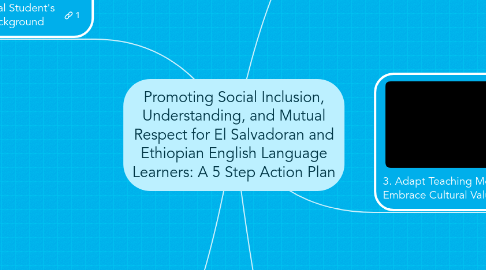
1. 1. Research the Individual Student's and Family's Cultural Background
1.1. Who:
1.1.1. Teachers
1.1.2. ESL Teachers
1.1.3. Other Staff Who Work with Student Regularly
1.2. What:
1.2.1. Learning about cultural background of student and family
1.3. Where:
1.3.1. Relationship Building with Student in the Classroom
1.3.2. With Student's Family through Home Visits and Continuous Communication
1.3.3. Independent Research by Staff Members
1.4. When:
1.4.1. Home Visit as Early as Possible
1.4.2. Relationship Building with Student as Early as Possible
1.4.3. Continuous Communication with Parents
1.5. How
1.5.1. Home Visits/Communication with Family
1.5.2. Relationship-Building with Student
1.5.3. Independent Research by Staff Members
1.6. Why
1.6.1. In order to adapt teaching to a student's needs, it is important to have a deep understanding of their culture and language. It is important to not make assumptions based on cultural stereotypes, but to get to know the student as an individual and her or his family.
2. 5. Seek Language Support
2.1. Who:
2.1.1. Teachers
2.1.2. ESL Teachers
2.1.3. Cultural Interpreter
2.2. What:
2.2.1. Specialized ESL Support and Services
2.2.1.1. Sheltered English
2.2.1.2. Peer Tutoring
2.3. When:
2.3.1. At the Earliest Signs that Support is Needed
2.4. Where:
2.4.1. Inclusive Classroom and Pull-Out Groups and One-on-Ones
2.5. How:
2.5.1. Sheltered Instruction in the general education classroom through the SIOP (Sheltered Instruction Observation Protocol) or pull-outs with an ESL teacher.
2.6. Why:
2.6.1. Students may need extra support with English Language Acquisition, especially in terms of academic content language. General education teachers, especially with the support of ESL teachers, can help students bridge languages, while learning grade-level content.
3. 2. Ensure that Classroom Visuals and Materials Represent Students' Cultural Groups and Languages
3.1. Who:
3.1.1. Teachers
3.2. What:
3.2.1. Ensure that Visuals, Books, and other Materials Represent Students' Cultural Groups and Languages
3.3. When:
3.3.1. As Early As Possible
3.3.2. Ongoing
3.4. Where:
3.4.1. Classroom (and hallways)
3.5. How:
3.5.1. Ensure Books Represent Students' Cultural Groups
3.5.2. Ensure that Visuals Represent Students' Cultural Groups
3.5.3. Ensure that Multimedia Resources Represent Students' Cultural Groups
3.6. Why:
3.6.1. In order to feel socially included, it is important that ALL students see themselves (and other people from the group they identify with) as included in the classroom and society instead of seen as "others".
4. 3. Adapt Teaching Methods to Embrace Cultural Values
4.1. Who:
4.1.1. Teachers
4.1.2. ESL Teachers
4.2. What:
4.3. When:
4.3.1. Planning, before a unit begins
4.3.2. Ongoing
4.4. Where:
4.4.1. Classroom
4.5. How:
4.5.1. Embracing Collectivism
4.5.1.1. Promoting Helpfulness
4.5.1.2. Group Celebration
4.5.1.3. Valuing Social Stories Equally with Scientific Information
4.5.1.4. Whole Group Activities
4.6. Why:
4.6.1. Adapting Teaching Methods to Embrace Cultural Values is important, because it signals to students that their cultural knowledge is important and valued. For example, in US schools where individualism is the norm, it is important that El Salvadoran and Ethiopian students' collectivist values are embraced.
5. 4. Ensure that Students have the Opportunity to Share their Culture and Build a Classroom Culture that Embraces Diversity
5.1. Who:
5.1.1. Teachers
5.1.2. Students
5.2. What:
5.2.1. Schedule
5.2.2. Budget
5.3. When:
5.3.1. Structured Diversity Curriculum
5.3.2. Teachable Moments
5.4. Where:
5.4.1. Classroom
5.5. How:
5.5.1. Opportunities for Cultural Sharing
5.5.2. Examination of Implicit Bias
5.5.3. Interrupting Cycles of Discrimination
5.6. Why:
5.6.1. In order for students to learn, they need to feel like they are in a safe classroom community where eveyone is welcome.
